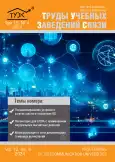Intelligent Method for Mutation of Input Cases with Feedback
- Authors: Samarin N.N.1, Tulinova A.V.1
-
Affiliations:
- Research Institute «Kvant»
- Issue: Vol 10, No 4 (2024)
- Pages: 142-148
- Section: INFORMATION TECHNOLOGIES AND TELECOMMUNICATION
- URL: https://journals.rcsi.science/1813-324X/article/view/263514
- DOI: https://doi.org/10.31854/1813-324X-2024-10-4-142-148
- EDN: https://elibrary.ru/GKUGLY
- ID: 263514
Cite item
Full Text
Abstract
About the authors
N. N. Samarin
Research Institute «Kvant»
Email: samarin_nik@mail.ru
ORCID iD: 0009-0007-4911-8471
SPIN-code: 6697-8926
A. V. Tulinova
Research Institute «Kvant»
Email: yarmak.av@ibks.spbstu.ru
ORCID iD: 0000-0002-7121-6031
SPIN-code: 2176-0939
References
- Muduli S.K., Roy S. Satisfiability modulo fuzzing: a synergistic combination of SMT solving and fuzzing // Proceedings of the ACM on Programming Languages. 2022. Vol. 6. Iss. OOPSLA2. PP. 1236−1263. doi: 10.1145/3563332. EDN:VUQLTQ
- Liu Z., Qian P., Yang J., Liu L., Xu X., He Q., et. al. Rethinking Smart Contract Fuzzing: Fuzzing with Invocation Ordering and I mportant Branch Revisiting // IEEE Transactions on Information Forensics and Security. 2023. Vol. 18. PP. 1237−1251. doi: 10.1109/tifs.2023.3237370. EDN:ZWKGJS
- Ерышов В.Г. Фаззинг тестирование. Классификация современных средств фаззинга // Сборник избранных статей по материалам научных конференций ГНИИ "Нацразвитие" Международные научные конференции (Санкт-Петербург, Россия, 26–31 августа 2021 года). СПб.: ГНИИ «Нацразвитие», 2021. С. 287−289. doi: 10.37539/AUG298.2021.94.77.007. EDN:QZILPI
- Situ L.-Y., Zuo Z.-Q., Guan L., Wang L.-Z., Li X.-D., Shi J., et. al. Vulnerable Region-Aware Greybox Fuzzing // Journal of Computer Science and Technology. 2021. Vol. 36. Iss. 5. PP. 1212−1228. doi: 10.1007/s11390-021-1196-0. EDN:PAPPKT
- Kim S.J., Shon T. Field classification-based novel fuzzing case generation for ICS protocols // The Journal of Supercomputing. 2018. Vol. 74. Iss. 9. PP. 4434−4450. doi: 10.1007/s11227-017-1980-3. EDN:TLEZVS
- Wei W., Li X., Zhang B., Li L., Damaševičius R., Scherer R. LSTM-SN: complex text classifying with LSTM fusion social network // The Journal of Supercomputing. 2023. Vol. 79. Iss. 9. PP. 9558−9583. doi: 10.1007/s11227-022-05034-w. EDN:TSXGJI
- Bayram F., Aupke P., Bestoun S.A., Kassler A., Theocharis A., Forsman J. DA-LSTM: A dynamic drift-adaptive learning framework for interval load forecasting with LSTM networks // Engineering Applications of Artificial Intelligence. 2023. Vol. 123. P. 106480. doi: 10.1016/j.engappai.2023.106480. EDN:WOXZSB
- Pierre A.A., Akim S.A., Semenyo A.K., Babiga B. Peak Electrical Energy Consumption Prediction by ARIMA, LSTM, GRU, ARIMA-LSTM and ARIMA-GRU Approaches // Energies. 2023. Vol. 16. Iss. 12. P. 4739. doi: 10.3390/en16124739. EDN:RKROHA
- Singh P., Kumar Ch., Kumar A. Next-LSTM: a novel LSTM-based image captioning technique // International Journal of System Assurance Engineering and Management. 2023. Vol. 14. Iss. 4. PP. 1492−1503. doi: 10.1007/s13198-023-01956-7. EDN:QUOVUU
- Wen X., Li W. Wen X. Time Series Prediction Based on LSTM-Attention-LSTM Model // IEEE Access. 2023. Vol. 11. PP. 48322−48331. doi: 10.1109/access.2023.3276628. EDN:ZAABGZ
- Ding T., Fu J., Shen R. Research on Multidimensional Mutation Strategy Method of Fuzzing Test // Proceedings of the 40th Chinese Control Conference (CCC, Shanghai, China 26–28 July 2021). Shanghai: IEEE, 2021. PP. 8639−8644. doi: 10.23919/CCC52363.2021.9550435. EDN:MJGBJG
- Manès V.J.M., Han H., Han C., Cha S.K., Egele M., Woo M. The Art, Science, and Engineering of Fuzzing: A Survey // IEEE Transactions on Software Engineering. 2021. Vol. 47. Iss. 11. PP. 2312−2331. doi: 10.1109/TSE.2019.2946563. EDN:ZDDKFN
Supplementary files






